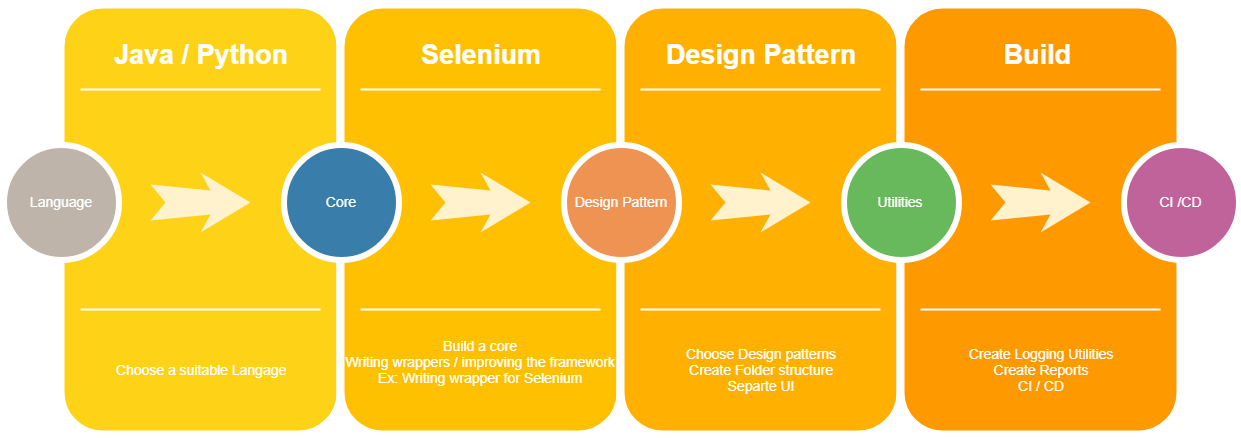Think of automation testing strategy like a recipe. No one ever begins baking a cake without having a firm grasp of the ingredients, the process, and the end product they’re hoping to attain. The same goes for automating your test scenarios: you need to have a strategy before you get started.
Any testing automation approach must fit into a larger, more comprehensive product testing strategy. This step ensures a more unified approach to your testing. Like any QA test strategy, an automated testing strategy lets you define goals, the scope of the test, the test environment, testing types, and testing levels.
Methods for Developing an Automated Testing Strategy
There is no universally applicable automation test framework that you can use for all projects. Each project needs a specific approach. However, you can develop an automation testing approach by following some guidelines and recommendations.
Set Specific Goals And Define The Scope
The success of an automation testing approach depends on having a well-defined and quantifiable endpoint. Once you decide on a target, direct all efforts to get there.
Defining the project’s scope is essential to save time in the long run. Automated testing frameworks, for instance, may perform tests that manual testers are already working on if their scope isn’t clearly defined. Even worse, it might not run some tests because of the uncertainty of whether or not they should be automated or tested manually. Large QA teams can have the possibility of this happening, which can have dire repercussions. Therefore, be specific while defining the scope.
Gather Requirements
Gather input from key stakeholders, establish objectives and key performance indicators, and document your testing needs. At this point, you should also specify the various forms of testing that you must perform to meet your needs. The information will help you select the right tools the next time.
Identify Potential Risks
Right now, it’s most important to focus on automating the processes that will have the most significant overall impact on the company. In this case, a risk-based testing strategy would be helpful. Prioritization is beneficial since it helps you sensibly organize your automation and determine when to stop. Automating low-priority tests, for instance, results in extra work for maintaining them, making them quickly obsolete, and provides little to no benefit.
Selecting Automated Test Cases
At this point, you should have an outline of the processes and functions that you need to automate. Prioritizing high-value business sectors is essential, but you should also consider the flow’s predictability and complexity. If a test case will undergo significant changes in the following sprint, automating it is a waste of time. Mark the areas of existing test cases that you should automate in light of the project’s declared objective, risks, and needs.
Define Test Environment And Test Data
A crucial aspect of a test automation strategy that gets overlooked is managing the testing environment and data. Because of the strict regulations imposed by GDPR, using fake data is often the best option. You must keep test data in separate files to make it simpler to update and stay up-to-date. Additionally, the test environment needs to be stable, and you must remove any testing artifacts left behind.
Select Technology and Framework
Your project and team will determine this aspect. For instance, if your staff already knows Python or Java, it is not wise to use a testing framework that only works with JavaScript unless those features are essential to your success.
Consequently, it is beneficial to perform research and build a PoC (proof of concept) at this time. This step will allow you to present the proof of concept to interested parties before deciding whether or not to continue developing the framework.
Track Your Development
Keeping tabs on your progress is also essential for knowing where you stand in the testing process and what you must accomplish. Here are two easy strategies:
Use your chosen test management tool to monitor the automation’s progress. You can initially track the obsolete, planned, and automated status, but you can always add more if necessary.
Utilize a ticket-tracking system to plan and monitor ongoing tasks. This step makes assigning tasks easy.
Reporting
Essential steps in automating processes include debugging test failures and reporting problems. But despite this, it usually takes longer than it should to address the true causes of problems. We can attribute most test failures to one of four causes; procedures should be in place to deal with them.
If there is a testing environment problem, let your DevOps team know through a ticket.
If there’s a problem with the app, let your developers know through a bug ticket.
Open a ticket notifying the QA team about the outdated automation script.
Open a ticket to the QA team to report a bug in the automation script.
Outline The Maintenance Procedure
Automating tests is not a discrete operation but rather a series of steps. Once you have created test cases, you must update them and track their outcomes. A formalized testing procedure is an excellent way to keep your tests from being outdated and forgotten. The first step is to create a ticket to update old scripts, and from there, you can establish priorities and deadlines. Any test that you haven’t run in a while is potentially a defect that could make it into the live system.
Conclusion
You can maintain your release cycles, deliver features frequently, and improve product quality with the help of test automation frameworks and the correct automated testing tools underpinned by a carefully planned strategy. While there are many things to consider, you can make the software development process more manageable by employing the best software testing plan for you and your company.



